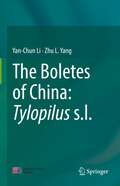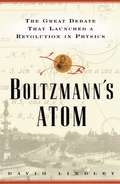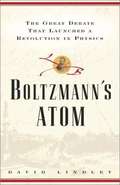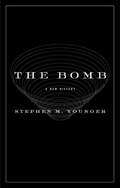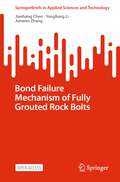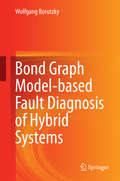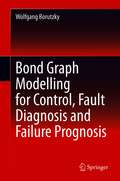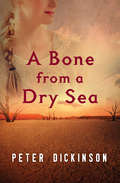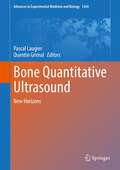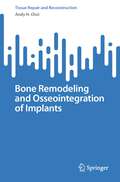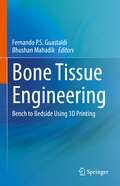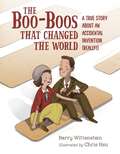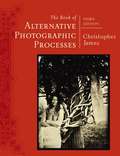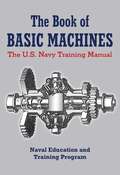- Table View
- List View
The Boletes of China: Tylopilus s.l.
by Yan-Chun Li Zhu L. YangThis book introduces the Chinese boletes, including the history, ecological and economic values, as well as the geographical distribution patterns with a highlight on the Tylopilus species. Species in Tylopilus s.l. are not only of important ecological values but also of scientific interests. They are very diverse in morphology, complex in structure and wide in ecological niches. China is one of the diverse hotspots of boletes, and many boletes were traditionally treated as members of Tylopilus based on hymenophore or spore-print colour. The studies revealed that the traditionally defined Tylopilus is polyphyletic. This book aims to elucidate the phylogenetic relationships among the genera treated in Tylopilus s.l. previously; to delimit and recognize the taxa, and finally to reveal the diversity of the genera and species of Tylopilus s.l. in China. The book is intended to be a reference for biologists who conduct investigations of biological resources and biodiversity; university and college teachers and students carrying out studies in related fields; mycologists and amateur mycologists, or people who interested in mushrooms taxonomy and systematics; and workers in the development of non-timber forest products.
Boll Weevil Blues: Cotton, Myth, and Power in the American South
by James C. GiesenBetween the 1890s and the early 1920s, the boll weevil slowly ate its way across the Cotton South from Texas to the Atlantic Ocean. At the turn of the century, some Texas counties were reporting crop losses of over 70 percent, as were areas of Louisiana, Arkansas, and Mississippi. By the time the boll weevil reached the limits of the cotton belt, it had destroyed much of the region’s chief cash crop—tens of billions of pounds of cotton, worth nearly a trillion dollars. As staggering as these numbers may seem, James C. Giesen demonstrates that it was the very idea of the boll weevil and the struggle over its meanings that most profoundly changed the South—as different groups, from policymakers to blues singers, projected onto this natural disaster the consequences they feared and the outcomes they sought. Giesen asks how the myth of the boll weevil’s lasting impact helped obscure the real problems of the region—those caused not by insects, but by landowning patterns, antiquated credit systems, white supremacist ideology, and declining soil fertility. Boll Weevil Blues brings together these cultural, environmental, and agricultural narratives in a novel and important way that allows us to reconsider the making of the modern American South.
Boltzmanns Atom: The Great Debate That Launched A Revolution In Physics
by David LindleyIn 1900 many eminent scientists did not believe atoms existed, yet within just a few years the atomic century launched into history with an astonishing string of breakthroughs in physics that began with Albert Einstein and continues to this day. Before this explosive growth into the modern age took place, an all-but-forgotten genius strove for forty years to win acceptance for the atomic theory of matter and an altogether new way of doing physics. Ludwig Boltz-mann battled with philosophers, the scientific establishment, and his own potent demons. His victory led the way to the greatest scientific achievements of the twentieth century. Now acclaimed science writer David Lindley portrays the dramatic story of Boltzmann and his embrace of the atom, while providing a window on the civilized world that gave birth to our scientific era. Boltzmann emerges as an endearingly quixotic character, passionately inspired by Beethoven, who muddled through the practical matters of life in a European gilded age. Boltzmann's story reaches from fin de siècle Vienna, across Germany and Britain, to America. As the Habsburg Empire was crumbling, Germany's intellectual might was growing; Edinburgh in Scotland was one of the most intellectually fertile places on earth; and, in America, brilliant independent minds were beginning to draw on the best ideas of the bureaucratized old world. Boltzmann's nemesis in the field of theoretical physics at home in Austria was Ernst Mach, noted today in the term Mach I, the speed of sound. Mach believed physics should address only that which could be directly observed. How could we know that frisky atoms jiggling about corresponded to heat if we couldn't see them? Why should we bother with theories that only told us what would probably happen, rather than making an absolute prediction? Mach and Boltzmann both believed in the power of science, but their approaches to physics could not have been more opposed. Boltzmann sought to explain the real world, and cast aside any philosophical criteria. Mach, along with many nineteenth-century scientists, wanted to construct an empirical edifice of absolute truths that obeyed strict philosophical rules. Boltzmann did not get on well with authority in any form, and he did his best work at arm's length from it. When at the end of his career he engaged with the philosophical authorities in the Viennese academy, the results were personally disastrous and tragic. Yet Boltzmann's enduring legacy lives on in the new physics and technology of our wired world. Lindley's elegant telling of this tale combines the detailed breadth of the best history, the beauty of theoretical physics, and the psychological insight belonging to the finest of novels.
Boltzmann's Tomb
by Bill GreenA selection of the Scientific American book clubRecommended by MSNBC, Los Angeles Times, & American Association for the Advancement of Science's SB&F magazine"This wonderful scientific memoir captures the romance and beauty of research in precise poetic prose that is as gorgeous and evocative as anything written by Rilke, painted by Seurat, or played by Casals." -Mary Doria Russell, author of Doc and The Sparrow"A radiant love letter to science from a scientist with a poet's soul . . . Green is an exquisite writer, and his fierce focus and mastery of style are reminiscent of the biologist and essayist Lewis Thomas." -Kirkus ReviewsIn Boltzmann's Tomb, Bill Green interweaves the story of his own lifelong evolution as a scientist, and his work in the Antarctic, with a travelogue that is a personal and universal history of science. Like Richard Holmes' The Age of Wonder-this book serves as a marvelous introduction to the great figures of science. Along with lyrical meditations on the tragic life of Galileo, the wildly eccentric Tycho Brahe, and the visionary Sir Isaac Newton, Green's ruminations return throughout to the lesser-known figure of Ludwig Boltzmann. Using Boltzmann's theories of randomness and entropy as a larger metaphor for the unpredictable paths that our lives take, Green shows us that science, like art, is a lived adventure. Bill Green is a geochemist and professor emeritus at Miami University in Oxford, Ohio. He is also the author of Water, Ice & Stone: Science and Memory on the Antarctic Lakes which received the American Museum of Natural History's John Burroughs Award for Nature Writing, was a finalist for the PEN/Martha Albrand Award, and was excerpted in The Ends of the Earth: An Anthology of the Finest Writing on the Arctic and the Antarctic, edited by Elizabeth Kolbert.
Boltzman's Atom
by David LindleyDescribes the history of Boltzman and his work in discovering atoms. Also goes into the philosophical debates involved.
The Bomb: A New History
by Steven M. YoungerA former Los Alamos weapons designer shares “an indispensable guide to the science and strategy of nuclear weapons” (Booklist).From his years at Los Alamos and the Nevada Test Site to his meetings with nuclear arms experts in Moscow, former weapons designer Stephen M. Younger has witnessed firsthand the making of nuclear policy. With a deep understanding of both the technology and the politics behind nuclear weapons, he guides us from the Manhattan Project to the Cold War and into the present day, illuminating how nuclear weapons fit into our globalized, war-plagued world. With startling clarity, Younger reveals how weapons work, the myths and realities of what happens after a nuclear explosion, and how our nuclear policy evolved to what it is today. In an era when rogue nations like North Korean and Iran strive to create their own precarious weapons programs, Younger provides much-needed background and insight for students, policy makers, and readers who wish to better understand the important issues involving nuclear weapons and national security.“Younger has provided an insightful guide, especially for the general reader, into today’s array of nuclear powers and their capabilities.” —James Schlesinger, former Secretary of Defense and Secretary of Energy
The Bomb and America's Missile Age (The Johns Hopkins University Studies in Historical and Political Science #133)
by Christopher GainorHow nuclear weapons helped drive the United States into the missile age.The intercontinental ballistic missile (ICBM), designed to quickly deliver thermonuclear weapons to distant targets, was the central weapons system of the Cold War. ICBMs also carried the first astronauts and cosmonauts into orbit. More than a generation later, we are still living with the political, technological, and scientific effects of the space race, while nuclear-armed ICBMs remain on alert and in the headlines around the world.In The Bomb and America’s Missile Age, Christopher Gainor explores the US Air Force’s (USAF) decision, in March 1954, to build the Atlas, America’s first ICBM. Beginning with the story of the guided missiles that were created before and during World War II, Gainor describes how the early Soviet and American rocket programs evolved over the course of the following decade. He argues that the USAF was wrongly criticized for unduly delaying the start of its ICBM program, endangering national security, and causing America embarrassment when a Soviet ICBM successfully put Sputnik into orbit ahead of any American satellite. Shedding fresh light on the roots of America’s space program and the development of US strategic forces, The Bomb and America’s Missile Age uses evidence uncovered in the past few decades to set the creation of the Atlas ICBM in its true context—not only in the America of the postwar years but also in comparison with the real story of the Soviet missiles that propelled the space race and the Cold War. Aimed at readers interested in the history of the Cold War and of space exploration, the book makes a major contribution to the history of rocket development and the nuclear age.
The Bomb in My Garden: The Secrets of Saddam's Nuclear Mastermind
by Mahdi Obeidi Kurt PitzerObeidi, the former director-general of Iraq's Ministry of Industry and Military Industrialization under Saddam Hussein, was involved in Iraq's quest for a nuclear bomb beginning in the late 1970s. In this memoir, he tells his story of his work in the program, describing how the efforts came to a halt after the first Gulf War, and how he watched as the U. S. used allegations he knew were false to justify the invasion of his country. In many parts, the story is as much personal as professional as he worries about the fate of his family in difficult times.
Bonanza Girl
by Patricia BeattyA widow and her two children head for gold rush territory in Idaho, hoping to find jobs and a new life.
Bond Failure Mechanism of Fully Grouted Rock Bolts (SpringerBriefs in Applied Sciences and Technology)
by Jianhang Chen Yongliang Li Junwen ZhangThe purpose of writing this book is to provide the latest research findings in ground control techniques in mining engineering, especially the rock bolting techniques. Since rock bolts are widely used in mining engineering and civil engineering, they are significant in guaranteeing the safety of underground openings. However, instability issues still occur with the rock bolting technique. Therefore, it is valuable to understand the exact load transfer mechanism of rock bolts. This book summarised the recent research work regarding rock bolting conducted by the authors. It is valuable for the readers to fully understand the reinforcing mechanism of fully grouted rock bolts. This book focuses on the bond failure mode of fully grouted rock bolts, which is the most widely encountered failure mode in rock bolting. Different investigation approaches are used in this book, including numerical simulation, analytical modelling and experimental tests. Therefore, this book conducts a comprehensive study to reveal the bond failure process of fully grouted rock bolts. Moreover, it reveals the corresponding bond failure mechanism. Therefore, it helps the reads to fully understand the bond failure mechanism of rock bolting. Moreover, it helps the readers to develop new approaches and methods to prevent failure of the rock bolting system.This is an open access book.
Bond Graph Model-based Fault Diagnosis of Hybrid Systems
by Wolfgang BorutzkyThis book presents bond graph model-based fault detection with a focus on hybrid system models. The book addresses model design, simulation, control and model-based fault diagnosis of multidisciplinary engineering systems. The text beings with a brief survey of the state-of-the-art, then focuses on hybrid systems. The author then uses different bond graph approaches throughout the text and provides case studies.
Bond Graph Modelling for Control, Fault Diagnosis and Failure Prognosis
by Wolfgang BorutzkyThis book shows in a comprehensive presentation how Bond Graph methodology can support model-based control, model-based fault diagnosis, fault accommodation, and failure prognosis by reviewing the state-of-the-art, presenting a hybrid integrated approach to Bond Graph model-based fault diagnosis and failure prognosis, and by providing a review of software that can be used for these tasks.The structured text illustrates on numerous small examples how the computational structure superimposed on an acausal bond graph can be exploited to check for control properties such as structural observability and control lability, perform parameter estimation and fault detection and isolation, provide discrete values of an unknown degradation trend at sample points, and develop an inverse model for fault accommodation. The comprehensive presentation also covers failure prognosis based on continuous state estimation by means of filters or time series forecasting. This book has been written for students specializing in the overlap of engineering and computer science as well as for researchers, and for engineers in industry working with modelling, simulation, control, fault diagnosis, and failure prognosis in various application fields and who might be interested to see how bond graph modelling can support their work.Presents a hybrid model-based, data-driven approach to failure prognosisHighlights synergies and relations between fault diagnosis and failure prognosticDiscusses the importance of fault diagnosis and failure prognostic in various fields
Bond Graph Modelling of Engineering Systems: Theory, Applications and Software Support
by Wolfgang BorutzkyThe author presents current work in bond graph methodology by providing a compilation of contributions from experts across the world that covers theoretical topics, applications in various areas as well as software for bond graph modeling. It addresses readers in academia and in industry concerned with the analysis of multidisciplinary engineering systems or control system design who are interested to see how latest developments in bond graph methodology with regard to theory and applications can serve their needs in their engineering fields. This presentation of advanced work in bond graph modeling presents the leading edge of research in this field. It is hoped that it stimulates new ideas with regard to further progress in theory and in applications.
Bond Graphs for Modelling, Control and Fault Diagnosis of Engineering Systems
by Wolfgang BorutzkyThis book presents theory and latest application work in Bond Graph methodology with a focus on: * Hybrid dynamical system models, * Model-based fault diagnosis, model-based fault tolerant control, fault prognosis * and also addresses * Open thermodynamic systems with compressible fluid flow, * Distributed parameter models of mechanical subsystems. In addition, the book covers various applications of current interest ranging from motorised wheelchairs, in-vivo surgery robots, walking machines to wind-turbines. The up-to-date presentation has been made possible by experts who are active members of the worldwide bond graph modelling community. This book is the completely revised 2nd edition of the 2011 Springer compilation text titled Bond Graph Modelling of Engineering Systems - Theory, Applications and Software Support. It extends the presentation of theory and applications of graph methodology by new developments and latest research results. Like the first edition, this book addresses readers in academia as well as practitioners in industry and invites experts in related fields to consider the potential and the state-of-the-art of bond graph modelling.
Bone Cement: From Simple Cement Concepts to Complex Biomimetic Design (SpringerBriefs in Applied Sciences and Technology)
by Andreas Öchsner Hamid Reza Rezaie Mohammad Hossein Esnaashary Masoud KarfarmaThis book provides an overview of the composition of polymeric and ceramic bone cements. It also discusses complex, biomimetic structures based on biomaterials, such as cells and bioactive molecules, which more closely resemble natural bone The first chapter describes the main concepts of the cementation process and the parameters affecting it, while the second chapter focuses on the composition and structure of candidate biomaterials. Lastly, the third and fourth chapters present recent research aimed at improving the ability of naked biomaterials to enhance bone healing by adding cells and bioactive agents.
A Bone from a Dry Sea
by Peter DickinsonOn a prehistoric shore, a young girl fights to help her tribe survive She is at home in the ocean, as comfortable in the water as she is on dry land. The child’s people have made their homes by the bay for as long as anyone can remember, diving for mussels and any other food the ocean will serve to them. They have no language; they have no names. Although they know love and jealousy and pride, they are not quite human—not yet. This child of the sea will show them the way. Two million years later, Vinny is visiting her father at an archaeological site in Africa when they discover the remains of that forgotten tribe of cliff dwellers. Across the ocean of time, these two young women will find a connection, an inexplicable bond that builds slowly but arrives with all the power of a tidal wave. This ebook features an illustrated personal history of Peter Dickinson including rare images from the author’s collection.
Bone Health in Children
by Steven A. Abrams Keli M. HawthorneBone health is one of the most widely discussed topics in pediatric nutrition. Ensuring adequate calcium and vitamin D intake is essential, and other factors also play a significant role. Bone Health in Children explores the recent decades of research and public commentary on the subject, debunks popular myths, and clarifies the often confusing and
Bone Quantitative Ultrasound: New Horizons (Advances in Experimental Medicine and Biology #1364)
by Pascal Laugier Quentin GrimalMany significant achievements in new ultrasound technologies to measure bone and models to elucidate the interaction and the propagation of ultrasonic waves in complex bone structures have been reported over the past ten years. Impaired bone remodeling affects not only the trabecular compartment but also the cortical one. Despite the crucial contribution of the cortical structure to the whole bone mechanical competence, cortical bone was understudied for a long time. A paradigm shift occurred around 2010, with a special focus placed on the importance of cortical bone. This has sparkled a great deal of interest in new ultrasound techniques to assess cortical bone. While our book ‘Bone Quantitative Ultrasound’ published in 2011 emphasized techniques to measure trabecular bone, this new book is devoted for a large part to the technologies introduced recently to measure cortical bone. These include resonant ultrasound spectroscopy, guided waves, scattering, and pulse-echo and tomography imaging techniques. Instrumentation, signal processing techniques and models used are detailed. Importantly, the data accumulated in recent years such as anisotropic stiffness, elastic engineering moduli, compression and shear wave speeds of cortical bones from various skeletal sites are presented comprehensively. A few chapters deal with the recent developments achieved in quantitative ultrasound of trabecular bone. These include (i) scattering-based approaches and their application to measure skeletal sites such as the spine and proximal femur and (ii) approaches exploiting the poro-elastic nature of bone. While bone fragility and osteoporosis are still the main motivation for developing bone QUS, this Book also includes chapters reporting ultrasound techniques developed for other applications of high interest such as 3-D imaging of the spine, assessment of implant stability and transcranial brain imaging. This book, together with the book ‘Bone Quantitative Ultrasound’ published in 2011 will provide a comprehensive overview of the methods and principles used in bone quantitative ultrasound and will be a benchmark for all novice or experienced researchers in the field. The book will offer recent experimental results and theoretical concepts developed so far and would be intended for researchers, graduate or undergraduate students, engineers, and clinicians who are involved in the field. The book should be considered as a complement to the first book publisher in 2011, rather than a second edition, in the sense that basic notions already presented in the first book are not repeated.
Bone Remodeling and Osseointegration of Implants (Tissue Repair and Reconstruction)
by Andy H. ChoiThis book provides an insight into the latest advances in bone fracture healing and remodeling algorithm and their incorporation into patient-specific finite element models and the use of machine learning and artificial intelligence to predict the bone regeneration and osseointegration process with a certain degree of accuracy. It also examines the applications of numerical models to simulate the fracture healing process, which may prove to be advantageous in determining the optimal mechanical-based treatment or reconstruction after an accident or illness. This book is aimed at medical and dental professionals who are involved in implantology and tissue engineering such as dentists, oral and maxillofacial surgeons, orthopedic surgeons, students, and researchers.
Bone Tissue Engineering: Bench to Bedside Using 3D Printing
by Fernando P. S. Guastaldi Bhushan MahadikThis book provides a comprehensive overview of the state-of-the-art research as well as current challenges and strategies to reconstruct large bone defects employing 3D printing technology. Various topics covered include different 3D printing technologies that can be applied for bioengineering bone, the aspects of basic bone biology critical for clinical translation, tissue engineering platforms to investigate the bone niche microenvironment, the pathway to clinical translation, and regulatory hurdles.Bone Tissue Engineering: State-of-the-Art in 3D Printing is an ideal book for students and researchers interested in learning more about the latest advances in employing different 3D printing technologies for bone tissue engineering.
Bones of the Earth: Three Science Fiction Thrillers
by Michael SwanwickModern technology is pitted against ancient dinosaurs in this scientific thriller James Rollins calls &“Jurassic Park set amid the paradox of time travel.&” Paleontologist Richard Leyster is perfectly content in his position with the Smithsonian excavating dinosaur fossil sites and publishing his findings . . . until the mysterious Harry Griffin appears in his office with a cooler containing the head of a freshly killed Stegosaurus. The enigmatic stranger offers Leyster the opportunity to travel back in time to study living dinosaurs in their original habitats—but with strings attached. Soon, the paleontologist finds himself, along with a select team of colleagues—including his chief rival, the ambitious and often ruthless Dr. Gertrude Salley—making discoveries that would prove impossible working from fossils alone. But when Leyster and his team are stranded in the Cretaceous, they must learn to survive while still keeping alive the joy of scientific discovery. This shocking novel spans hundreds of millions of years and deals with the ultimate fate not only of the dinosaurs but also of all humankind. Nominated for the Locus Award, the Hugo Award, and the Nebula Award for Best Novel, Bones of the Earth cements author Michael Swanwick as an author who &“proves that sci-fi has plenty of room for wonder and literary values&” (San Francisco Chronicle).
Bonneville 928: Land Speed Racing in a Porsche 928
by Carl FausettBonneville 928 is a must read for any car enthusiast. Within, Carl Fausett chronicles his journey of taking a modified German performance car to the most American of events; the Bonneville land speed record race. Fausett masterfully portrays the unique challenges of adapting a street car to a land speed record spec, a standard that is basically peerless in the motorsports world. Through simple, heartfelt storytelling, we take the journey alongside Fausett and experience his highs and lows as he attempts to capture the land speed record in his class. Bonneville 928 is a worthy read for anyone who loves to modify cars; Fausett, in his characteristics down to earth fashion pulls no punches and tells you everything that worked and didn't work with his car, giving the reader valuable insights into what it takers to go fast. This book is also written with the common car enthusiast in mind, and Fausett builds the car on a limited budget, unlike many of his competitors. It's a real David vs Goliath tale about a normal guy with a gutsy crew and an ambitious dream. If you like Porsche 928s, and you've ever wondered how the car stacks up against the world's best, this book is for you.
The Boo-Boos That Changed the World: A True Story About an Accidental Invention (Really!)
by Barry WittensteinDid you know Band-Aids were invented by accident?! And that they weren't mass-produced until the Boy Scouts gave their seal of approval?1920s cotton buyer Earle Dickson worked for Johnson & Johnson and had a klutzy wife who often cut herself. The son of a doctor, Earle set out to create an easier way for her to bandage her injuries. Band-Aids were born, but Earle's bosses at the pharmaceutical giant weren't convinced, and it wasn't until the Boy Scouts of America tested Earle's prototype that this ubiquitous household staple was made available to the public. Soon Band-Aids were selling like hotcakes, and the rest is boo-boo history."Appealingly designed and illustrated, an engaging, fun story" — Kirkus Reviews STARRED REVIEW
The Book of Alternative Photographic Processes (3rd Edition)
by Christopher JamesA complete and comprehensive technical and aesthetic resource, exploring and delving into every aspect of alternative photographic process photography. This 3rd Edition is the definitive text for students and professionals studying alternative photographic processes and the art of hand-made photographic image making. The text brings the medium up to date with new and historic processes that are integrated with the latest contemporary innovations, adaptations, techniques, and art work.
The Book of Basic Machines: The U.S. Navy Training Manual
by U. S. NavyHave you ever wondered why levers and pulleys make it easy to lift heavy objects? Or thought about what it is that makes a combustion engine work?The Book of Basic Machines will give you the information you need to understand key concepts, techniques, components, and much more. Designed and prepared by the Naval Education and Training Program Development Center for naval training, and taught widely in technical school across the country, the manual covers the theory and application of many of the most important mechanical ideas. Concepts build effortlessly from one chapter to the next. Clear explanations, illuminating examples, and over 200 skillfully rendered diagrams, cross-sections, and illustrations make it remarkably easy for readers of any level to understand the fascinating inner-workings of basic machines. The Book of Basic Machines is an invaluable resource for mechanical engineering students looking to learn the basics, working engineers wanting to brush up on some theory, or hobbyists who simply want to know how things work. Simply put, this book is required reading for anyone interested in machines. From the basics of simple levers to the principles of the internal combustion engine, The Book of Basic Machines covers every aspect of basic machinery.
